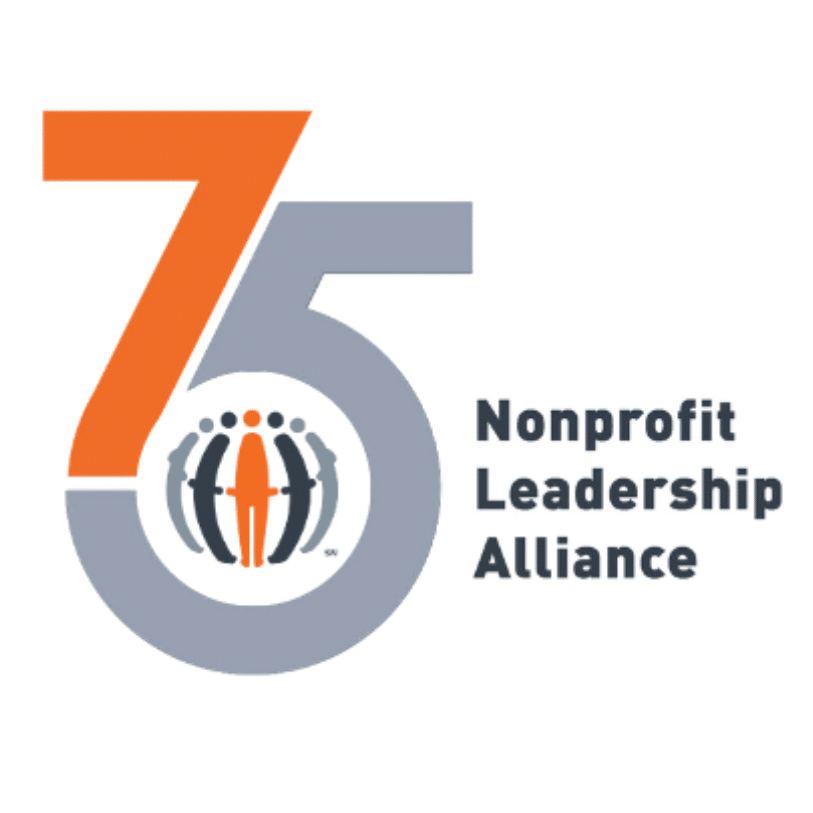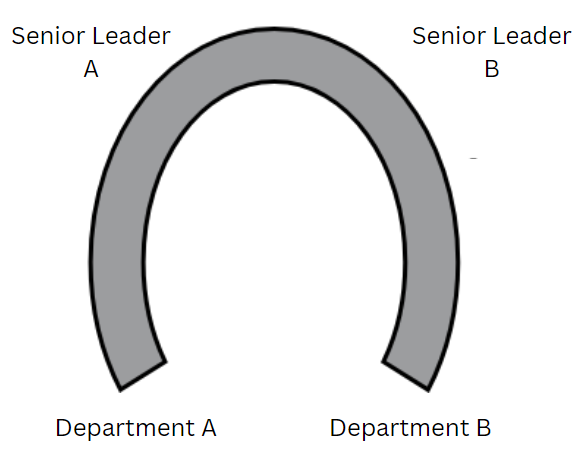Building influence and driving change in an organization can be a challenging task, particularly for those without formal authority. As social change leaders, you are responsible for fostering a culture of growth and development within the organization, ensuring that employees have the necessary skills to drive the organization forward.
However, you probably work at an organization where each department works in a “horseshoe” format – meaning nobody collaborates well and communication takes way too long – traveling up the chain of command, across, and then back down. How could you implement a cross-organizational initiative knowing that everyone is focused on their own priorities?
This is the essence of influence – being able to persuade, inspire, and guide others towards a shared goal or outcome – all without relying on formal authority or hierarchical power. Effective influence in the workplace requires an individual to understand the interests, motivations, and values of their colleagues, and to use this understanding to tailor their approach and messaging to achieve the desired outcome.
Influence is especially crucial for individuals who may not have formal leadership roles but still need to accomplish their objectives through others, such as HR professionals, development professionals, project managers, and other stakeholders. These individuals must be able to build relationships and persuade others to take action or adopt new ideas, even if they don’t have the authority to command them. In this sense, influence is a key skill for anyone who wants to achieve success in the workplace, regardless of their position or title.
But what organizational barriers exist?
There are 5 typical systemic hurdles that are common to every organization:
- Resistance to change: There may be a lack of support, resistance to feedback, or even cultural barriers and resistance to new ideas. You may also face the perception of being an order taker as well as a very real systemic issue of high turnover and limited time to develop and implement long-term strategies
- Lack of resources: Companies may also face limited access to data and info for decision-making, insufficient buy-in from employees and other departments, and difficulty keeping up with rapid changes in technology and industry standards.
- Communication and alignment: Siloed departments and conflicting priorities can lead to lack of alignment between business objectives and employee development goals. When you don’t have formal authority, you also may not have access to all communication channels, making it difficult to get your message across and you usually won’t have the power to make key decisions, which can hinder progress on initiatives.
- Lack of understanding: Stakeholders may not fully understand the value of your initiatives, making it difficult to gain their support and buy-in for the value of learning and development initiatives.
- Lack of Trust and Credibility: Without formal authority, it can be difficult to get visibility with key decision-makers and stakeholders, making it harder to influence their decisions.
By not having a clear understanding of these barriers and how influence works, you’ll continue to feel like you’re “spinning your wheels”. In the rest of this article, we’ll cover the 3 big mistakes you’re making around influencing others and how to overcome them.
Mistake #1: You’re not spending enough time on building social capital.
In an increasingly complex world, it’s vital to be seen as a trusted advisor. The social capital you build can then be used to move initiatives forward. The main problem is that many people view this as playing politics and refuse to participate. However, the foundation of influence always begins with a good relationship and trust.
A more useful alternative is to view your role as customer service. This means having the mindset of identifying and serving the needs of other leaders and departments. It means helping them solve their most pressing issues in a collaborative process. A common theme across industries and roles is the idea that when people know you and know how much you care, the more likely they’ll be willing to work with you and do things for you.
Recognize also that influence is a marathon, not a sprint. Just like managing any other project, maintaining the relationships is an ongoing task. That means:
- Getting personal: let them see who you really are and find out what really motivates them.
- Regularly reaching out to department heads and keep them informed of progress.
- Following up on commitments.
- Managing setbacks collaboratively and calmly.
- Maintaining positivity and persistence.
- Calling out the wins, especially when a major milestone is completed, give praise to the senior leaders involved. It’s rare for people in higher positions to hear praise and accolades.
Mistake #2: You’re not clear about goals and expectations
The reality is that leaders across all organizations and departments are busy. In a time when budgets are getting tighter and people are expected to do increasingly more with increasingly less, everyone is trying to stay above water with their own work. Senior leaders are being pitched to all the time, so their response is to poke holes in what’s being pitched.
It’s not enough to solely be clear about your goals (although, that’s the starting point). The other side of the coin is being clear about what you need from the other person/department. The clearer you can be about what you need and how your project will benefit someone else, the higher your chances of success.
In addition:
- Find common goals/objectives by talking through both their ideas and yours.
- Take the time to understand what they want by asking questions – telling them what to do won’t go very far.
- Tie what you want to what they want AND tie it to a timeframe.
Mistake #3: You’re not looking at the big picture and thinking how your priority ties to the larger business goals.
As with everything you do, your projects and tasks should be aligned with helping the organization reach its goals. It should be abundantly clear how your projects and tasks solve the bigger problems. This is the foundation of moving from an order taker to a strategic advisor – demonstrating your ability to think big picture and holistically. That means your initiatives should be outcomes-based from the beginning, not only process focused.
Start by getting familiar with your organization’s strategic plan and priorities. To really set yourself apart, have conversations with senior leaders around how you can help move the priorities forward from your division and how you can support other departments in executing that strategic plan. If needed, be willing to put your own ideas on the backburner to show you are committed to the organization’s success.
In addition, focus on outcomes and the overall benefit to organization. Proactively use data and metrics to measure these outcomes and success. The more clearly you define what success may look like ahead of time, the easier it is to get people on board with your vision and gain allies.
Takeaways
In today’s workplace, the art of influence without formal authority has become indispensable. This article underscores that it’s not just about persuasion; it’s about forging connections, nurturing trust, and fostering an environment of shared outcomes. Overcoming barriers requires proactive engagement, authenticity, and aligning business goals with human potential.
The themes uncovered here, from aligning with business objectives to cultivating unbreakable relationships, illuminate a path forward. Whether you’re in HR, project management, or a leadership role, these principles offer a way forward. Influence is a collaborative symphony of empathy and dedication. By integrating these insights, you possess the power to drive change and shape your organization’s future through genuine connections!
About the Author
Chris Wong, LMHC, CEC
Chris is a certified executive coach who brings a wealth of experience and expertise to the world of leadership and learning and development. With a background as a former therapist and training manager, Chris has helped countless professionals navigate complex situations with confidence and achieve exceptional results. When he oversaw leadership and organizational development at a nonprofit, Chris orchestrated multiple leadership and career development initiatives, fostering a strong leadership pipeline within the organization.
Certified as an executive coach, Chris works with nonprofit executives to create engaged and human-centric workforces so they can focus on the impact they want to have. This includes helping leaders navigate difficult conversations, resolve conflicts, create high performing cultures, enhance productivity, and cultivate an inclusive and equitable work environment. His expertise spans diverse areas, including leadership development, strategic planning, leading change, and diversity, equity, and inclusion.
Get nonprofit tips and tools delivered right to your inbox by joining The Nonprofit Leadership Alliance Newsletter. Our bimonthly newsletter will make sure you know what’s happening with our network of social sector leaders.

